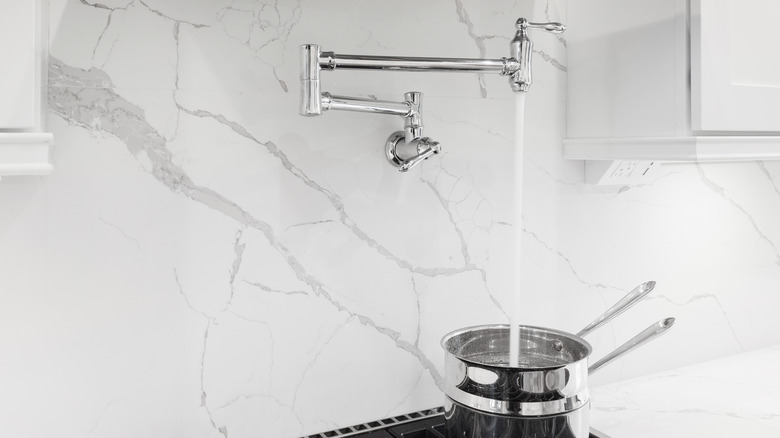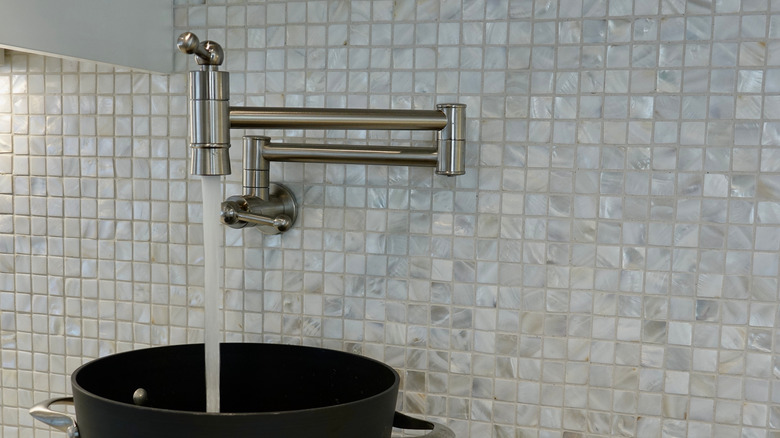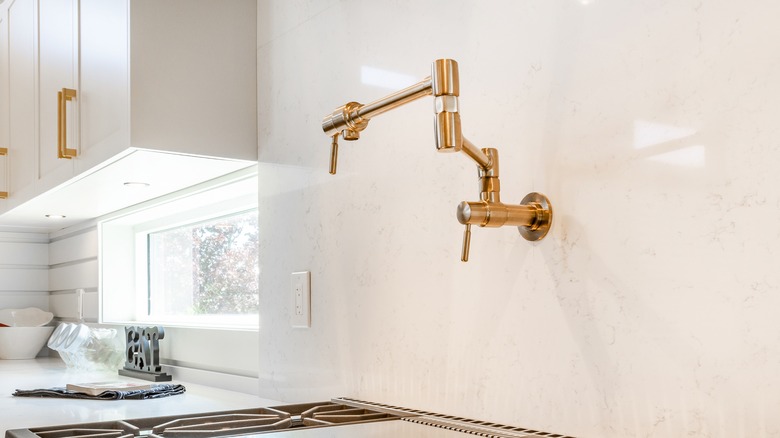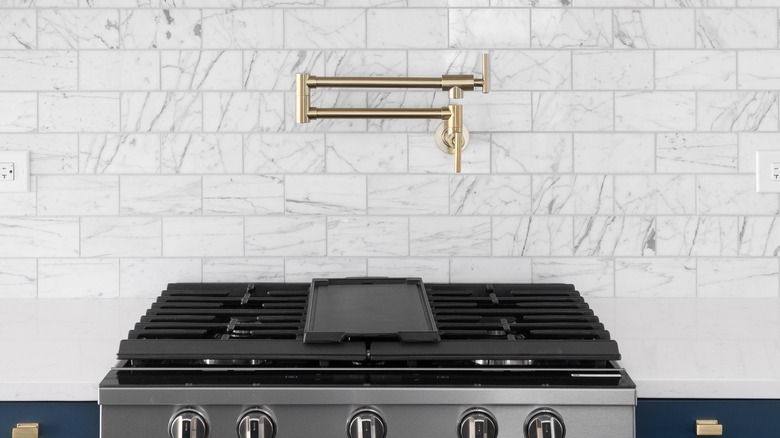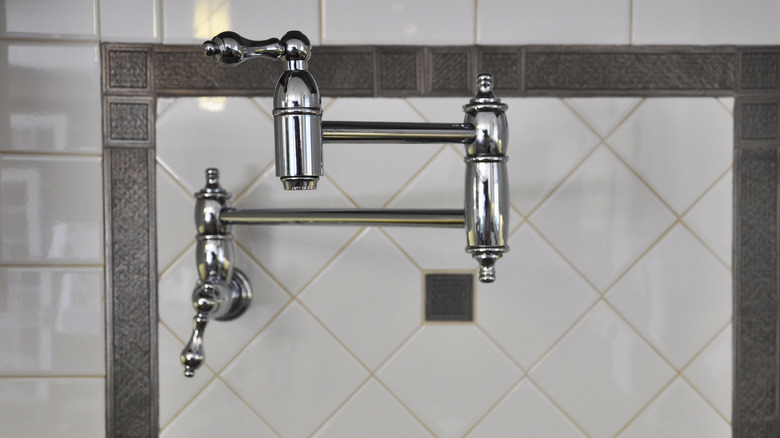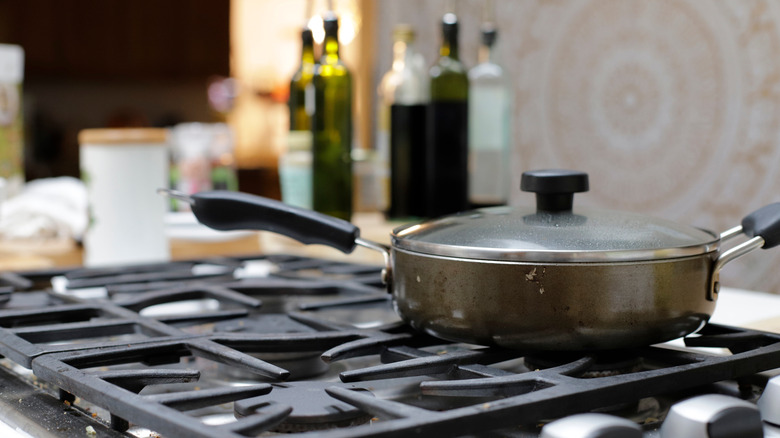Pros And Cons Of Having A Pot Filler Faucet In Your Kitchen
Also known as a kettle filler or pasta arm, pot fillers are a more rare type of faucet. They typically have a faster flow rate than an average kitchen tap, and most are designed to fold in and out and have a flexible arm so that you can fill a pot anywhere on your cooktop, via Kingston. The question is, will you get enough use out of this kitchen add-on to justify its installation? As per usual, this greatly depends on your lifestyle.
For example, what kind of cook are you? What recipes do you typically create? Do you make meals that require large pots of water? If you're answering positively, you should consider purchasing this invaluable tool. However, it might not be a good idea if you're not someone who does any of that. If you're still unsure, here are some pros and cons of pot fillers to help make your decision.
1. Pot fillers flow faster but that may be unneeded to some
Standing at the sink waiting for a pot to fill with water can be frustrating when you're trying to get dinner on the table. It can be time-wasting as it extends the duration of the food preparation process. But with a pot filler, you could set the pot on the stove, pull out the arm and fill it quickly, per MyMove. As mentioned above, they are designed to have faster flow rates and can fill even a massive pot in just seconds.
Alternatively, a faster flow rate wouldn't matter if you don't often fill large pots of water. Likewise, if you don't have a big family to feed or have plenty of time in your day, rushing to make dinner might not be necessary, and it might even be the time of day when you slow down and relax with a glass of wine. A standard kitchen faucet should be your go-to if you are in this category.
2. They simplify the pot-filling process but not the emptying
No matter how much you enjoy cooking, carrying that big pot of water from the sink to the stove is a treacherous journey. All it takes is one slip on the floor or a kid's toy to send those gallons of water flying across the room. A pot filler removes that risk, and you don't have to carry a big pot of water from the sink to the stove, via Mr. Cabinet Care. This can be especially helpful for those with an excessively heavy Le Creuset. While they are fantastic pots and pans to have in your collection, there's no denying their hefty weight.
While all that is true, keep in mind that the risk and lifting task isn't entirely gone as you still have to carry the cooking utensil from the cooktop to drain the pasta or dump the leftovers into a container. So even though a pot filler replenishes a large pot efficiently, it does not contribute to the cumbersome emptying process.
3. Pot fillers aid multitasking but may damage your cooktop
For many, the kitchen is the central point for all family activities. Not just for breakfast, lunch, and dinner, but also for snack time, homework, morning coffee, and late-night tea. Therefore, there's almost always possible that the kitchen sink and faucet are already in use or filled with dirty dishes. Instead of cleaning the whole kitchen to start dinner, you can get the water going with the pot filler while you clean the sink or prep the rest of the meal. It also means you can make that after-dinner cup of tea a bit earlier since you shaved valuable minutes off your time.
The only downside is that there is no drainage under the pot filler to catch any drips or leaks. In such situations, your cooktop may become susceptible to rust and all the other damages water can cause — even if it's a minimum drip or leak, via Toulmin Kitchen & Bath. This can be a massive con; you may have to attend to the pot while filling, making the multitasking benefit irrelevant.
4. A pot filler is gorgeous, but is the cost worth it?
Pot fillers are handy but also an attractive part of a kitchen layout and can add a sense of luxury to any space. A pot filler could be a central piece that combines the whole thing with a stunning backsplash and a gorgeous stove. If you're sold on the fact that you would use a pot filler all the time, but you're a bit uncertain of the aesthetics or resale value, don't be. They add a lot of value to the home; even if they don't use it a lot, potential buyers almost always see it as a bonus.
Unfortunately, pot fillers are a bit of an expensive kitchen fixture, commanding a price tag between $475 and $1,100, per Costimates. Not only are the faucets themselves expensive, but the installation is complicated and could add a pretty high cost to your overall budget. In addition, it requires all new plumbing to a location in the kitchen where there usually isn't much of it. And even the more affordable pot fillers are still not cheap.
5. Though practical, they can be tough to clean
If you've ever tried to clean the tiles behind your stove, you probably know just how gross it can get. The whole area around the stove is usually covered in grease, debris, and oil splatters. Even if you aren't a messy cook, there's just no getting around the popping and splashes when you drop that garlic in the olive oil. That's why pot fillers get so messy and often break more frequently than other faucets in the kitchen. Situated above the stove, they quickly get grimy, via Toulmin Kitchen & Bath.
Additionally, their multiple jointed arms can make them hard to clean. It would be best to clean them after every cooking session or at least once a week. But there's no ignoring that installing a pot filler in your kitchen will add another thing to your home that you'll have to clean and take care of. This might be the biggest downside to some since there isn't enough time in the day.
